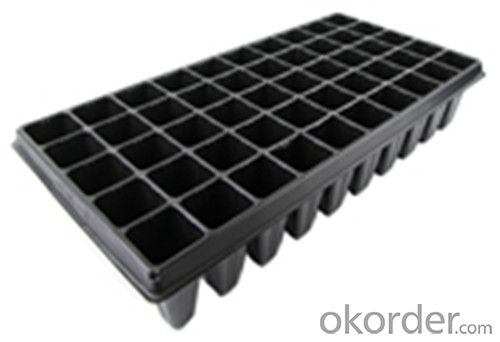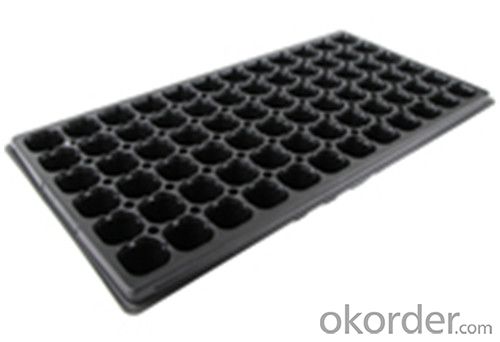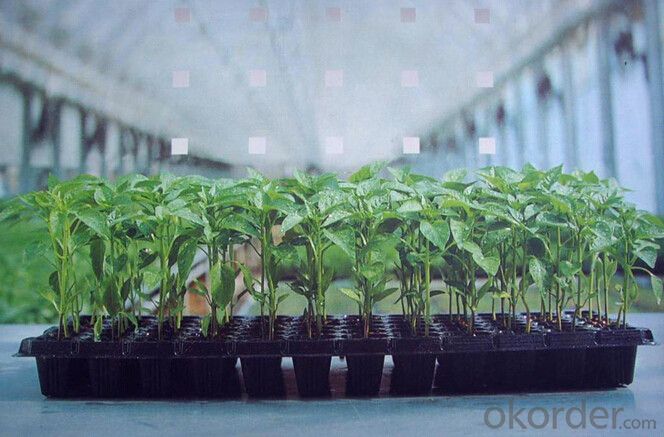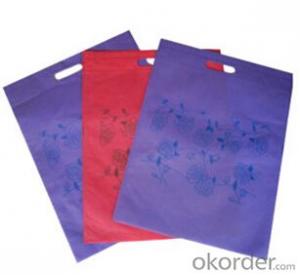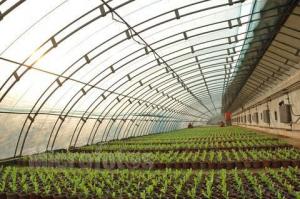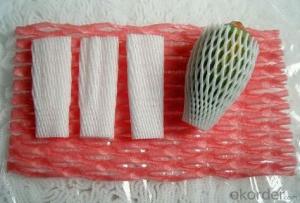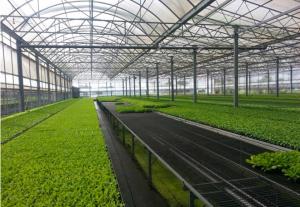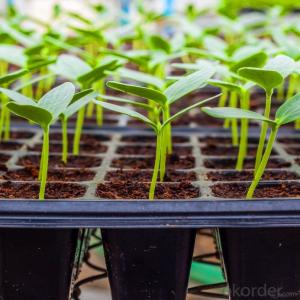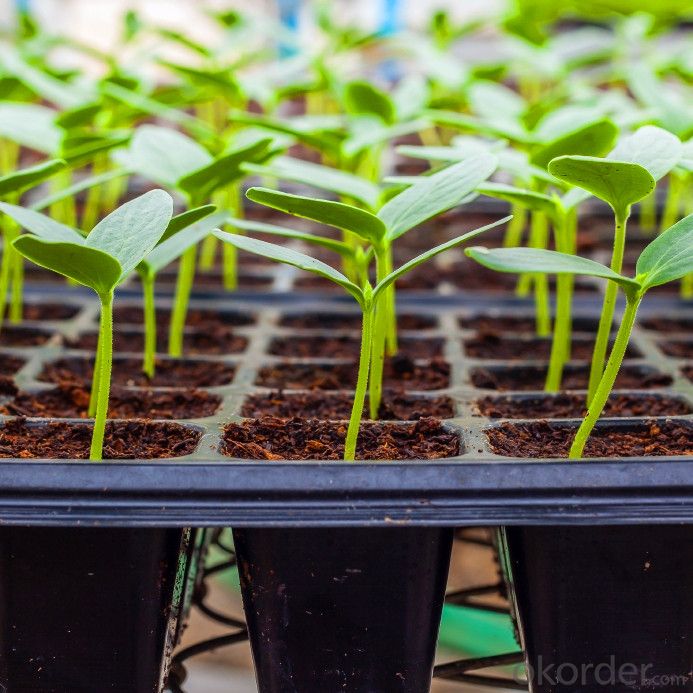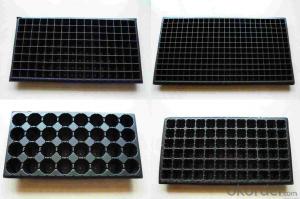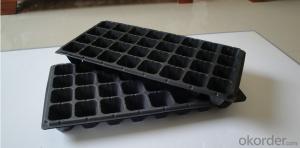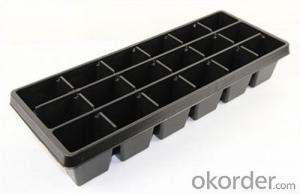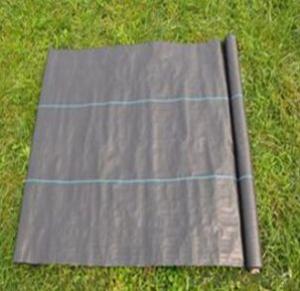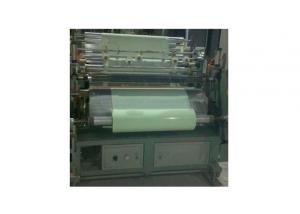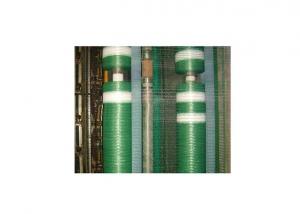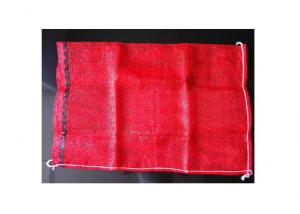Planting Plastic Seeding Tray for Greenhouse PVC HIPS Seed Tray
- Loading Port:
- China main port
- Payment Terms:
- TT OR LC
- Min Order Qty:
- 1000 pc
- Supply Capability:
- 10000000 pc/month
OKorder Service Pledge
OKorder Financial Service
You Might Also Like
Structure of the seed tray: · Top quality and competitive price. · Variety design and good appearance. · Easy to use, and remove. · Durable and reusable. · Eco-Friendly.
Advantages: · Top quality and competitive price. · Variety design and good appearance. · Easy to use, and remove. · Durable and reusable. · Eco-Friendly.
Application: · Ideal for Starting seeds and Transplanting Seedling. · Suitable for both manual and automatic planting. · Suitable for Propagating Vegetables, Flowers and other plant from seed · in green-house or indoors.
Description Main Features of the seed tray: · Ideal for Starting seeds and Transplanting Seedling. · Suitable for both manual and automatic planting. · Suitable for Propagating Vegetables, Flowers and other plant from seed in green-house or indoors. Using time: · thickness of 0.5mm can be used 1 to 2 times. · thickness of 0.6mm can be used 3 to 4 times. · thickness of 0.7mm can be used 5 to 6 times. · thickness of 0.8mm can be used 7 to 8 times. · thickness of 0.9mm can be used 8 to 9 times. · thickness of 1.0mm can be used 8 to 10 times. Thickness vs. Weight: · Thickness of trays are from 0.5mm to 1.0mm. · 1.0mm: 155g±5g; 100pcs/ctn. · 0.9mm: 140g±5g; 120pcs/ctn. · 0.7mm: 110g±5g; 150pcs/ctn. · 0.6mm: 95g±5g; 180pcs/ctn. · 0.5mm: 80g±5g; 200pcs/ctn.
Seed Tray Specification: Materialps/pvcThickness0.5mm-1.5mm, standard:1mmWeight80g(±5)g-230g(±5)g, Standard weight:155g(±5)gSizelength:490mm-540mm, width:190mm-345mm,depth:25mm-150mm Standard:54mmX28mmCell count18-512Packagein cartonUsing time8-10 times
FAQ: Q:How Can I Get A Sample? A:You can get samples by communicate with our export sales. Q:How Long Is Delivery? A:Delivery time will be 7-25 days according to order quantity. Q:What Is The MOQ? A:Our MOQ is 1*20FT container quantity, allow to mix several items. Q:What Is Our Normal Payments Terms? A:Our normal payment terms now is T/T, L/C or Western Union,Papal. Q:How Do I Order Your Products? A:You can check our website for any items you interest and you can also get communication with our export sales and order for it accordingly. Q:What Kinds Of Material We Use In Our Product? A:Our plastic flower pots use material such as PP polymer or PE polymer.
|
- Q: can the mold Aspergillus grow on plastic?
- very confusing matter. browse on yahoo. that could actually help!
- Q: What are the advantages of using agricultural plastic products?
- There are several advantages of using agricultural plastic products. Firstly, they provide protection to crops from pests, diseases, and extreme weather conditions, thus increasing yields. Secondly, they help in conserving water by reducing evaporation and maintaining soil moisture. Thirdly, they improve soil health by preventing weed growth and reducing the need for herbicides. Additionally, agricultural plastic products are lightweight, easy to handle, and cost-effective, making them a convenient choice for farmers. Lastly, these products can be reused, recycled, or properly disposed of, promoting sustainability in agriculture.
- Q: What are the advantages of using plastic ground cover sheets for weed suppression?
- There are several advantages of using plastic ground cover sheets for weed suppression. Firstly, these sheets act as a physical barrier, preventing sunlight from reaching the soil and inhibiting weed growth. Additionally, they help conserve moisture by reducing evaporation, thus promoting healthier plant growth. Plastic ground cover sheets are also durable and long-lasting, providing a cost-effective solution compared to other weed control methods. Finally, they can be easily installed and removed, allowing for convenient maintenance and cultivation of desired plants.
- Q: How do I prepare the soil for ground cover?
- To prepare the soil for ground cover, start by removing any weeds, rocks, or debris from the area. Loosen the soil using a garden fork or tiller to a depth of 6-8 inches. Next, amend the soil with organic matter, such as compost or well-rotted manure, to improve its fertility and drainage. Rake the soil smooth and level it before planting the ground cover.
- Q: What are nursery trays used for?
- Nursery trays are used for starting and growing young plants, providing a controlled environment for seedlings to develop before they are transplanted into larger containers or outdoor gardens.
- Q: What are the possible uses for agricultural plastic products after their initial purpose has been fulfilled?
- <p>Yes, there are alternative uses for agricultural plastic products after their primary use. These include recycling to produce new plastic products, repurposing as mulch in gardens, or using them for constructing low-cost greenhouses. Some plastics can be transformed into oil through a process called pyrolysis. Additionally, they can be used as a raw material for manufacturing composite lumber or other construction materials. It's important to note that proper disposal and recycling are crucial to minimize environmental impact.</p>
- Q: Can ground cover plants be used to create a natural border?
- Yes, ground cover plants can be used to create a natural border. Ground cover plants are low-growing and spread quickly, making them an excellent choice for creating a dense and visually appealing border. They provide natural beauty, help to control erosion, and can even deter weeds. Additionally, ground cover plants require less maintenance compared to other types of borders, making them a practical and sustainable option.
- Q: How do agricultural plastic products help in preventing soil erosion?
- Agricultural plastic products, such as plastic mulch and erosion control blankets, help prevent soil erosion by providing a protective barrier against wind and water erosion. These products create a physical barrier that shields the soil from the impact of heavy rain, wind, and other natural elements, reducing the risk of soil erosion. Additionally, plastic mulch helps retain moisture in the soil, promoting plant growth and further preventing erosion.
- Q: I have plastic trays that had bearings in them . Over time will the oil in the trays cause any chemical reaction ?
- If bearing oil is petroleum-based, then yes eventually it will eat the plastic.
- Q: Are agricultural plastic products resistant to extreme weather conditions?
- Yes, agricultural plastic products are designed to be resistant to extreme weather conditions. They are often made from durable materials that can withstand intense heat, cold, wind, and rain. This allows them to be used in various climates without significant damage or deterioration.
Send your message to us
Planting Plastic Seeding Tray for Greenhouse PVC HIPS Seed Tray
- Loading Port:
- China main port
- Payment Terms:
- TT OR LC
- Min Order Qty:
- 1000 pc
- Supply Capability:
- 10000000 pc/month
OKorder Service Pledge
OKorder Financial Service
Similar products
Hot products
Hot Searches
Related keywords




